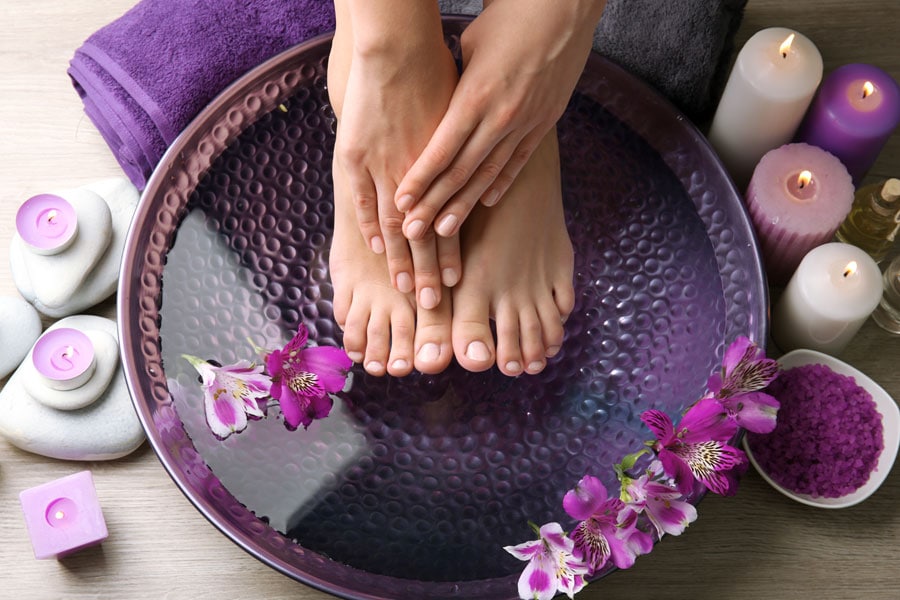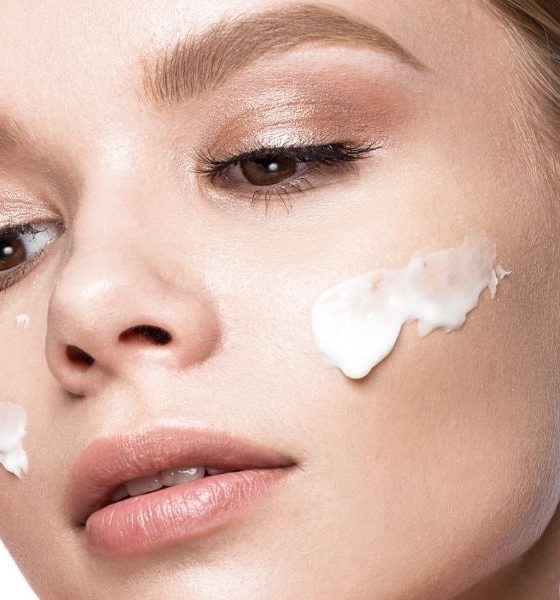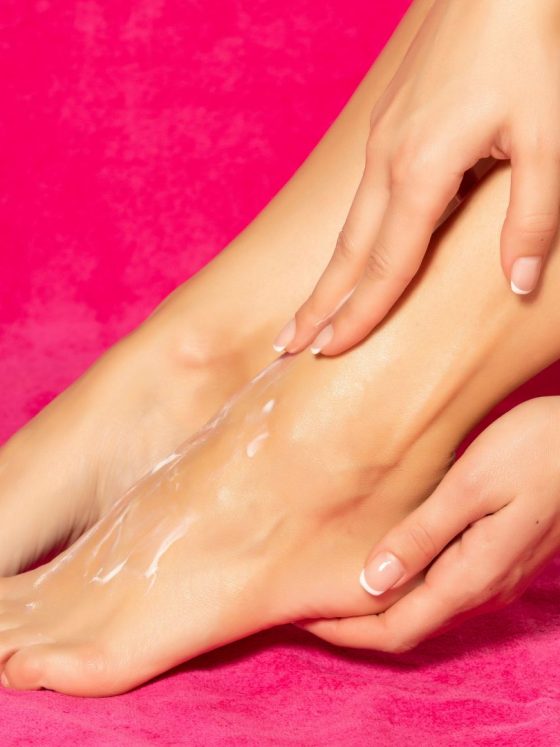Best DIY Cracked Heels Treatment: 13 Amazing Home Remedies to Soften Hard Skin

Looking for the best DIY cracked heel treatment?
Lots of products are available in your local drugstore to moisturize your feet — lotions, muds and additives for foot baths — but you can make your own soothing, softening foot bath out of natural ingredients already in your pantry.
JUMP TO:
Who Gets Cracked Heels and Why?
Cracked feet (especially in the heel region) is a common foot problem for both men and women caused by dry skin (also known as xerosis) that becomes more prominent around the rim of the heel.
Thick patches of skin called calluses often form, leaving behind yellow or dark brown discoloration. The cracks that follow are pretty obvious and if they continue to worsen, bearing weight on the feet will cause pain.
Examining the surface of the skin will help an individual detect the signs and symptoms of dry, cracked feet.
The most common alerts include red or flaky patches; peeling or cracked skin; and discharge or bleeding. At times, the skin will also itch.
What Causes Heel Cracks?
In order to avoid and treat dry, cracked feet, it is important to get down to the source of the problem. There are numerous reasons why the feet can become excessively dry (to the point of cracking) such as :
1) Lengthy Periods of Standing
Whether you’re at work or at home, prolonged standing (especially on hard floors) can wreak havoc on the feet.
2) Obesity
Being overweight increases the amount of pressure the fat pad located under your heel will encounter. If your skin is not flexible, the chances of experiencing a crack in the skin increase, as the fat expands sideways.
3) Type of Shoes
Wearing a shoe with an open back or finding it hard to give up love favorite pair of sandals can cause dry cracks in the feet due to a lack in support for the fat pad located under your foot.
4) Diseases and Skin Conditions
Some medical problems create a vulnerability to excessive drying of the skin, such as diabetes — notorious for placing the feet in danger. Well-known skin conditions, such as psoriasis or eczema, also causes dry, cracked feet in patients. Other conditions to consider include Athletes’ foot and thyroid disease.
5) Bodily Factors
Possessing active sweat glands or suffering from heel spurs can cause dry, cracked feet to develop. The shape of your feet may trigger the condition to emerge, as seen in people with flat feet or high arches. Poor alignment of the metatarsal bones, which is responsible for the bone structure of the soles of your feet, can also contribute to dry, cracked feet.
6) Surgery
Sometimes, surgery done to the lower extremities can cause dryness and cracks in the feet.
7) Your Walk
Patients that show abnormalities or inconsistencies in the way they walk could place too much pressure on the bottom of their feet.
8) Hot Water
If you have a habit of soaking your feet in excessively hot water, the chances of suffering dryness and cracked feet will increase.
Crack Feet Risk Factors and Negative Effects
While dry, cracked feet is a cosmetic issue at best, some people battle fissures and deep cracks that make it impossible to go through an entire day without wincing or limping.
Severe cases bring infection that calls for surgery or debridement — where dead, damaged, or infected tissue is removed from the body.
Cellulitis is another negative effect of severe dry, cracked feet, which causes a patient to develop a fever, headaches, and nausea. While anyone can suffer varying levels of the condition, there are risk factors to acknowledge:
1) Age
The older you get, the thicker and drier the skin becomes as it increasingly loses its natural elasticity.
2) Are Cracked Heels a Sign of Diabetes?
Diabetic patients are at a great risk for suffering the negative setbacks of dry, cracked feet, including diabetic foot ulcers. Neurological damage is also common in diabetics, where one loses feeling in their feet and is sometimes unaware of a growing foot problem.
3) Poor Hygiene
Ignoring proper hygiene in regards to the feet will increase the risk of developing dry and cracked heels.
4) Improper Footwear
Wearing shoes that do not fit your feet can increase your chances of suffering dry, cracked feet. Beware of excessively wearing sandals and shoes with open backs as well.
5) Climate
Living in a certain climate (such as a dry, humid location) can cause the skin to become dry and scaly.
6) Poor Diet
What you eat can affect the health of your feet, especially when you show a deficiency in vitamins, minerals, and zinc.
Natural Cures for Dry, Cracking Feet
Dry, cracked feet is a problem that truly places a damper on slipping into sandals for the summertime or setting the mood with your sweetie. To ease the discomfort and embarrassment of this condition, try taking a step in the right direction with the following natural cures for soothing dry and cracked feet:
1) Hydrogenated Vegetable Oil
Following a thorough wash of the feet, apply a thick coat of hydrogenated vegetable oil to dry and cracked sections. Wear a thick pair of socks to bed and leave on overnight. Repeat until results are seen, which usually come within a few days.
2) Banana Pulp
Treat cracked heels with the pulp of a ripe banana, leaving it on for 10 minutes and rinsing afterwards.
3) Glycerin and Rosewater
Combine glycerin and rosewater to create a soothing remedy for cracked heels.
4) Paraffin Wax and Mustard Oil
Melt paraffin wax and mix well with a bit of mustard oil. Apply to dry and cracked feet, making sure to rinse off in the morning. It is suggested to continue application for 10 to 15 days for the best results.
5) Natural Pumice Stone
Remove the thick, dead skin that accumulates on heels by using a natural pumice stone, such as the Terra Cotta Pumice Stone – Premium Callus Remover, which cleanses, exfoliates, and reduces the appearance of dry, cracked heels.
6) Over-the-Counter Herbal Balm
Keep the heels of your feet soft by using a medicated herbal balm that also helps to close fissures. Ingredients to look out for include the relaxing power of lavender and the soothing, softening properties of coconut oil.
Or learn how take care of your feet with the best products for your feet.
What Can I Soak My Cracked Feet In?
The combination of a foot bath and massage can jumpstart the healing process to create feet that are not only healthy, but soft.
7) Rice Bath
Cook up a cup of ordinary rice in 5 cups of water for 20 minutes, until the rice is tender. There should be about 3 cups of extra water in the pot. Add 3 tbsp. of baking powder.
Wait for it to cool enough to be tolerable to your skin — don't burn yourself! Transfer it to a container that is just large enough to fit your feet, and soak those tootsies until the water is cold.
8) Milk Bath
Milk has many components that soothe and soften the skin. Mix 1/4 cup milk, 1/4 cup lemon juice and 1/4 cup water.
Add 2 tbsp. of olive oil for extra softening, and a pinch of cinnamon. Mix the ingredients and soak your feet in the solution. It is recommended to repeat this treatment twice a week.
9) Salt Bath
This recipe makes a very deep bath, with 20 cups of water, so use a large container. Boil the water, and when it is slightly cooled, add a cup of sea salt or Epsom salt.
Then add about 6 drops of essential oil — either lavender, sandalwood or ylang ylang. If you want, you can also add 4 cups of whole milk for extra efficacy.
10) Oil Bath
Many oils have a softening effect on skin: you could massage olive oil or any hydrogenated vegetable oil directly onto your feet to help treat the hard skin. For a foot bath, boil enough water to cover your feet in your container of choice. Allow it to cool slightly and then add 3 drops of peppermint oil and 1 drop of eucalyptus oil. As an added bonus, put in some tea tree oil, which fights fungus, if you have athlete's foot.
11) Herbal Foot Bath
Boil five liters of water and allow to slightly cool before adding two drops of lavender essential oil and 1 cup of sea salt (or Epsom salt) before soaking the feet. While lavender allows the feet to relax and soften, this herbal recipe also works wonders by substituting the lavender for soothing sandalwood or Ylang Ylang oils.
12) Peppermint or Tea Tree Oil Foot Soak
For a foot bath or suitable container, boil enough water to cover your feet and ankles. Allow the water to cool down before adding three drops of relaxing peppermint essential oil and one drop of eucalyptus essential oil. Lemon essential oil is optional, but can increase the overall sensation of the foot soak. You may also opt for a tea tree essential oil foot soak to effectively fight fungal infections.
13) Create a Skin Softening Bath
Treat your feet to a skin softening bath using 1/4 fresh lemon juice, two tablespoons of olive oil, 1/4 cup of milk, 1/4 cup of water, and a pinch of cinnamon. Mix all ingredients together and add to a container for soaking the feet. It is recommended to soak the feet twice per week.
Contrary to popular belief, the issue of dry, cracking feet can turn into much more than a simple beauty defect. With natural cures, you can at least increase your chances of recovery and find gentle treatments that soothe and heal.








